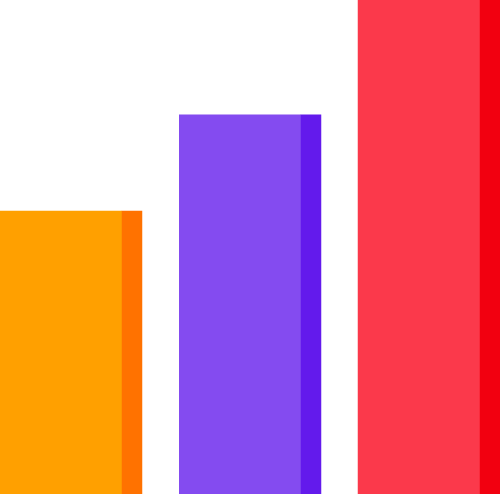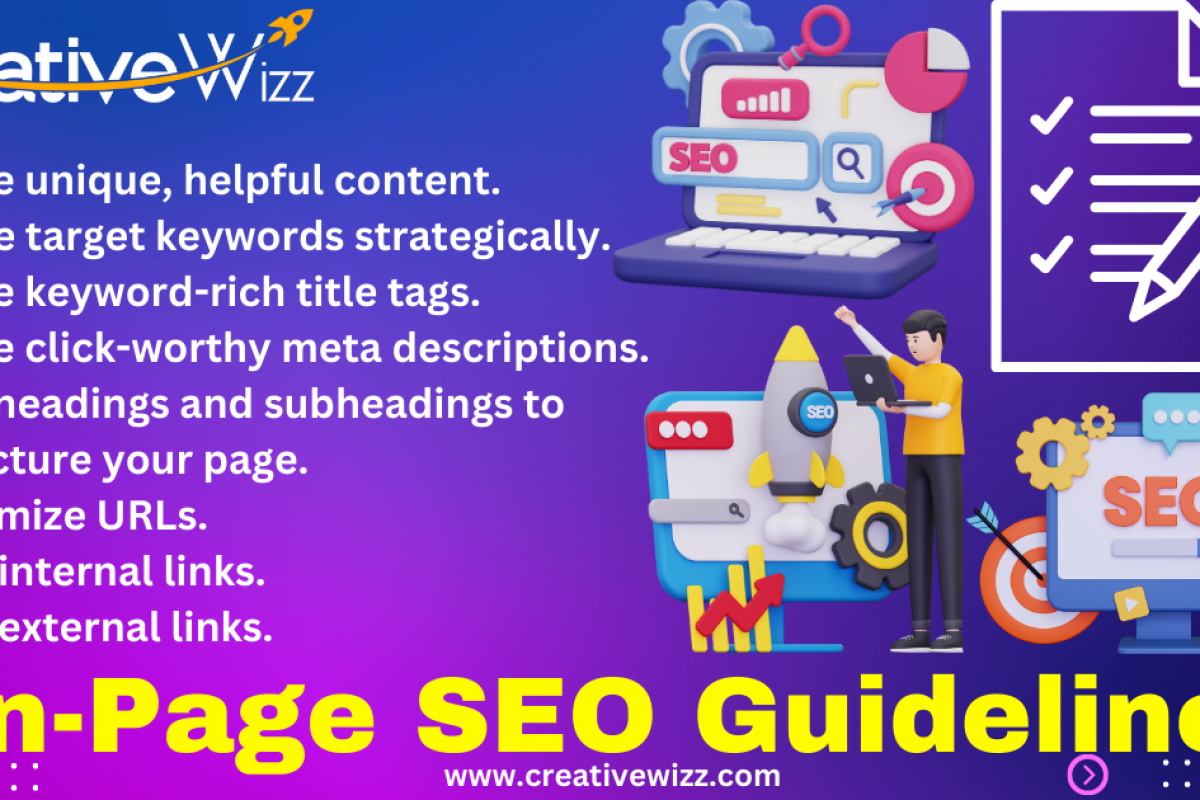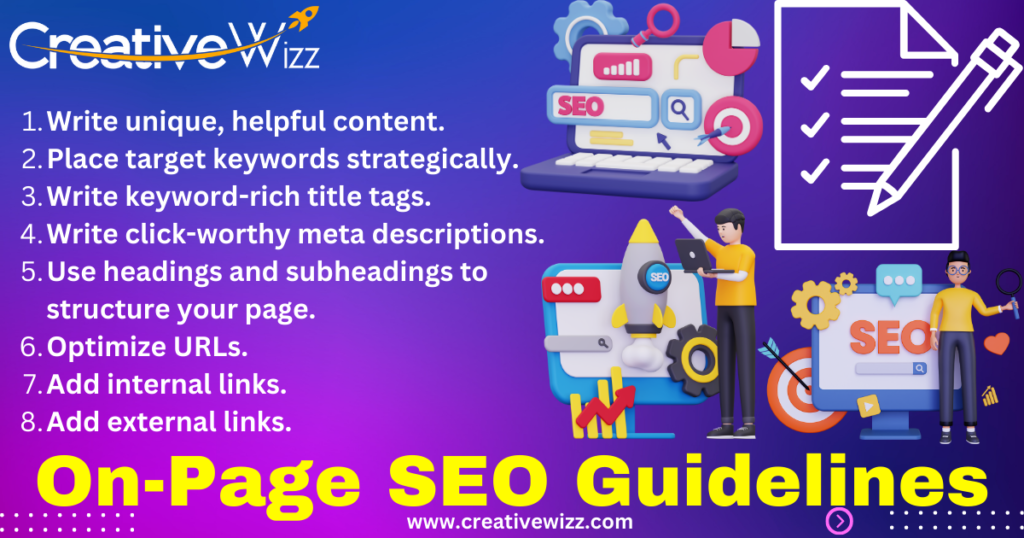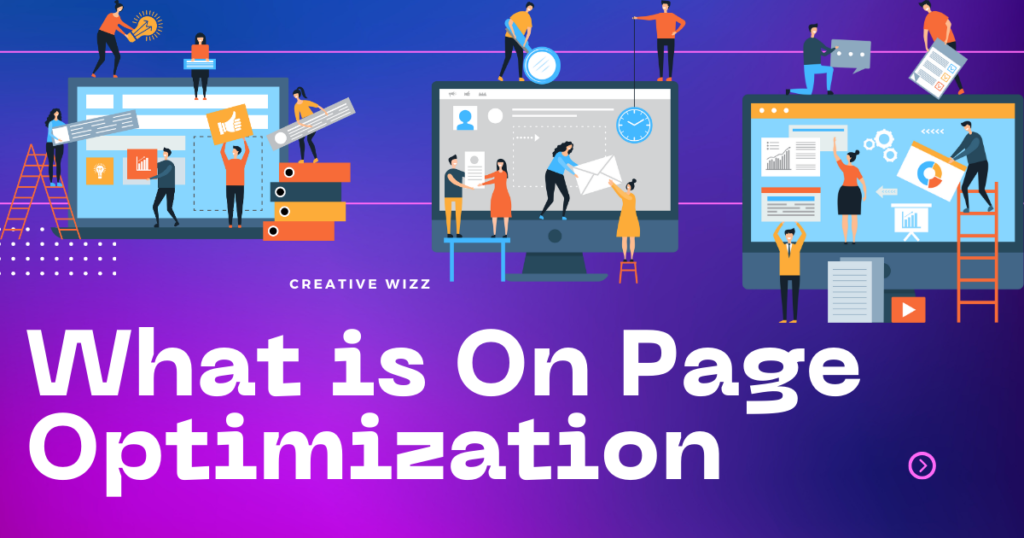On-page SEO forms the foundation of a strong overall search optimization strategy. By optimizing elements on your actual web pages, you can improve how search engines index and rank your site.
This comprehensive guide will cover the most important on-page SEO guidelines and best practices recommended by leading experts like Moz. We’ll explore essential optimization techniques for new and existing websites.
Follow these on-page SEO tips to boost your Google rankings and organic visibility over time.
Why Follow On-Page SEO Guidelines?
Optimizing your web pages for search helps in several key ways:
- Improves search engine visibility – Higher rankings and more traffic.
- Enhances user experience – Better navigation, engagement, and conversion.
- Establishes credibility and authority – Signals expertise in your industry.
- Increases conversions – More qualified visitors find you through SEO.
- Cost-effective marketing – SEO has a higher long-term ROI than paid ads.
By making changes directly on your website through on-page SEO, you can control how search engines like Google assess your content and determine where to rank it in results.
Moz’s Recommended On-Page SEO Guidelines

Moz is one of the leading authorities in SEO best practices. Their on-page optimization guidelines focus on relevance, authoritativeness, and content presentation.
Here are Moz’s top on-page SEO recommendations:
- Create Descriptive Page Titles
Page titles are critical for SEO. Titles should:
- Accurately describe the page content
- Include target keywords near the front
- Be unique for each page
- Entice searchers to click and visit
- Keep under 60 characters
Example title structure:
Copy code
{Keyword} {Topic} | {Brand}
Example title:
On-Page SEO Guidelines | Creative Wizz
- Add Meta Descriptions
While meta descriptions don’t impact rankings directly, compelling descriptions improve click-through rates from search results.
Effective meta descriptions:
- Provide an engaging overview of the content
- Are under 160 characters
- Incorporate keywords naturally
- Optimize URL Structure
Search-friendly URL structure helps pages rank better. Best practices:
- Short, simple, and keyword-focused – example.com/category/postname
- Use dashes between words vs underscores
- Avoid excessive keywords just for SEO
- Static URLs vs dynamic query strings
- Improve Page Speed
Faster page load speeds enhance user experience and search performance. Test site speed and optimize where possible – caching, image compression, efficient code, etc.
- Make Content Scannable
Break up text content with reader-friendly formatting:
- Informative subheadings (H2, H3 tags)
- Short paragraphs and lists
- Bold and italicize text selectively
- Images, videos, and illustrations
This improves readability and helps visitors quickly find information.
- Include Multimedia
Images, videos, charts, etc, make content more engaging. Optimize them with file names, alt text, and captions containing keywords.
- Promote Internal Site Linking
Linking between related content provides better on-site navigation and promotes the discovery of more pages. Use keywords naturally in anchor text.
- Follow a Clear Information Architecture (IA)
Intuitive site navigation, taxonomy, structure, and labeling help search bots crawl and users find what they need easily.
These On-Page SEO Techniques form the core of Moz’s SEO recommendations. Next, we’ll cover more advanced techniques.
Advanced On-Page SEO Guidelines and Tips

Beyond the fundamentals, there are additional best practices sites can implement for improved on-page SEO:
Leverage Header Tags
Header tags (H1, H2, H3) indicate content structure. H1 should reflect the main topic. Lower headers provide supporting details.
Implement Structured Data
Schema markup and structured data communicate page information for rich search features. JSON-LD is the best format.
Mobile Optimization
With mobile-first indexing, ensure pages are responsive or have separate mobile versions. Minimize slow elements on mobile.
Quality Content
The best on-page SEO focuses first on creating valuable, engaging content. Optimize for visitors, not just algorithms.
Technical Site Health
Proper redirects, valid HTML, minimal errors, and fast servers impact crawler accessibility.
Local SEO Signals
For local businesses, include city, business type, and contact info prominently on pages.
Security
SSL certificates and HTTPS, eliminating vulnerabilities, signals safety and security to visitors and search engines.
While not exhaustive, these tips cover the main advanced on-page SEO best practices to incorporate.
On-Page SEO Checklist for Websites
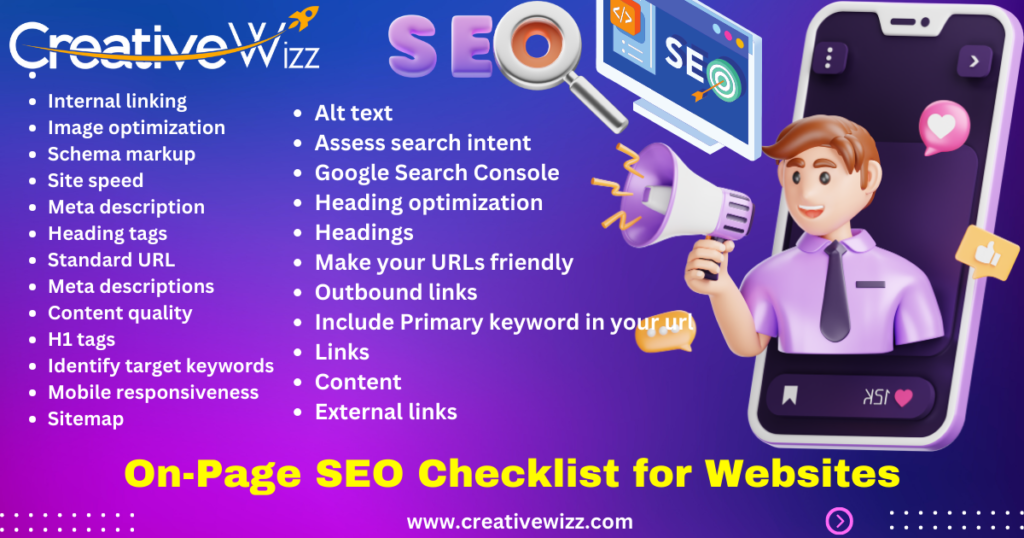
Here is a convenient on-page SEO checklist to audit and optimize websites:
Content
- Descriptive page titles with keywords
- Meta descriptions optimized for each page
- Quality content focused on user needs
- Scannable text with header tags, formatting, multimedia
- Target keywords are included naturally throughout the content
Technical
- Fast page load speeds
- Mobile-friendly responsive design
- Proper redirects and internal linking
- Strong information architecture and navigation
- Optimized structured data and schema markup
Media
- Images, video, and graphics enhanced with titles, alt text, captions, and keywords
- Compressed media for fast-loading
Code
- Short, keyword-focused page URLs
- Valid HTML and minimal technical errors
- HTTPS and SSL security enabled
Performance
- Google Analytics installed to track SEO KPIs
- Google Search Console integrated to monitor indexing and performance
- Regular crawl analysis to catch any issues early
This checklist helps identify areas needing improvement and address gaps in on-page SEO.
On-Page SEO Tips for New Websites

For new sites just starting with on-page SEO, focus first on:
- Brainstorming keywords and topics to target
- Creating optimized page titles and meta descriptions
- Writing high-quality content focused on user intent
- Improving site speed performance
- Setting up Google Analytics and Search Console
- Adding structured data markup
- Creating an intuitive IA and navigation
- Linking internally between related pages and content
- Fixing any indexing or crawl errors
- Testing different title formulas and meta descriptions
Get your technical SEO foundations in place to ensure your site is search-friendly.
Common On-Page SEO Mistakes to Avoid
Some common on-page optimization mistakes include:
- Weak, duplicated, or missing page titles and meta descriptions
- Over-optimizing content and metadata with keywords
- Poor page speed and mobile optimization
- Low-quality thin content to populate pages
- Excessive ads above the fold disrupt user experience
- Outdated designs with broken navigation or links
- Lacking structured data for rich results
Avoiding these critical errors ensures your on-page SEO is effective. Monitor your page titles, speeds, and content quality over time.
Key Takeaways for On-Page SEO Best Practices
Following SEO guidelines and best practices for optimizing your web pages, you can significantly improve your site’s ranks in Google.
Focus on creating quality content, enhancing technical site health for crawling, optimizing media, and signaling relevance through titles, URLs, and markup.
On-Page SEO Guidelines: A Comprehensive Guide by Creative Wizz
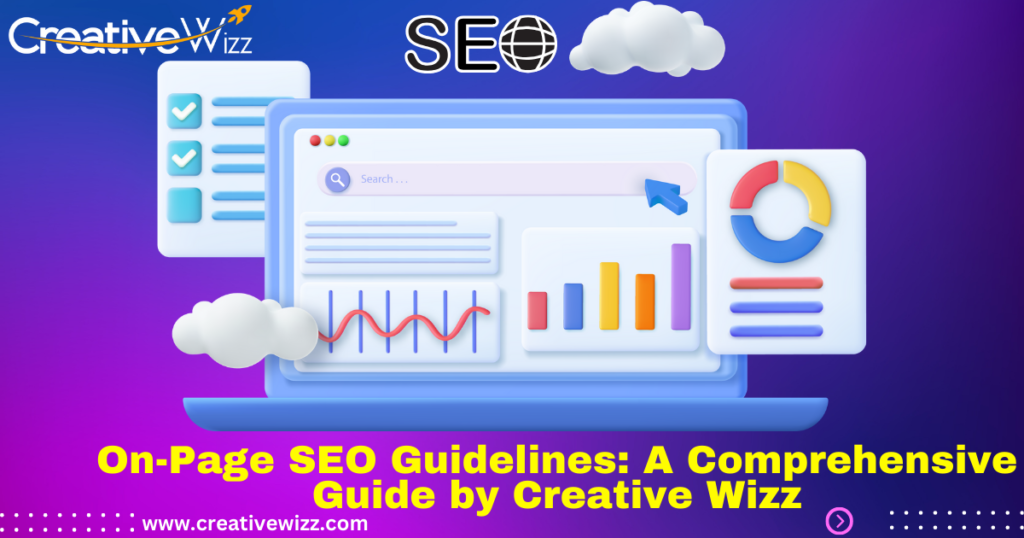
In digital marketing, on-page SEO guidelines are crucial for any website’s success. This article will delve into the various on-page SEO techniques and provide a detailed guide to help you optimize your website for better visibility and ranking on search engines.
Moz On-Page SEO Guidelines
Moz, a well-known name in the SEO industry, provides comprehensive on-page SEO guidelines that can help improve your website’s visibility and ranking on search engines. Here are some key takeaways from the Moz on-page SEO guidelines:
- Keyword Placement: The placement of keywords in your content plays a crucial role in on-page SEO. Including keywords in the title, headings, and content is important.
- Meta Tags and Descriptions: Meta tags and descriptions give search engines information about your webpage. They should be descriptive and contain your main keywords.
- URL Structure: URLs should be SEO-friendly, short, and descriptive. Including your main keyword in the URL can improve your on-page SEO.
- Content Quality: High-quality, original content is among the most important on-page SEO factors. It should provide value to your readers and include your keywords naturally.
- Image Optimization: Images should be optimized for speed and include alt text with relevant keywords.
- Internal Linking: Internal links help search engines understand the content and structure of your website, improving its visibility and ranking.
On-Page SEO Guidelines for New Websites
Following the on-page SEO guidelines can set you up for success if you launch a new website. Here are some on-page SEO guidelines for new websites:
- Keyword Research: Before creating content for your website, it’s important to conduct thorough keyword research. This will help you understand what your target audience is searching for and allow you to create content that meets their needs.
- Site Structure: A well-structured website makes it easier for search engines to crawl and index your pages. It also improves user experience, which is a key factor in SEO.
- Mobile Responsiveness: With the increasing use of mobile devices, your website must be mobile-friendly. A mobile-responsive website improves user experience and is favored by search engines.
- Page Load Speed: A fast-loading website provides a better user experience and is favored by search engines. Therefore, optimizing your website’s speed by compressing images, minimizing HTTP requests, and reducing server response time is important.
- Secure Website (HTTPS): Google gives a slight ranking boost to secure websites. Therefore, it’s recommended that you use HTTPS for your new website.
On-Page SEO Checklist
An on-page SEO checklist can be handy to ensure you get all the important SEO factors. Here’s a simple on-page SEO checklist template that you can use:
- Keyword Placement: Are your keywords included in the title, headings, and throughout the content?
- Meta Tags and Descriptions: Have you included descriptive meta tags and descriptions with your main keywords?
- URL Structure: Are your URLs SEO-friendly, short, and descriptive?
- Content Quality: Is your content high-quality, original, and valuable to your readers?
- Image Optimization: Are your images optimized for speed, and do they include alt text with relevant keywords?
- Internal Linking: Have you included internal links in your content to help search engines understand the structure of your website?
- Mobile Responsiveness: Is your website mobile-friendly?
- Page Load Speed: Is your website fast-loading?
- Secure Website (HTTPS): Is your website secure (HTTPS)?
Why On-Page SEO is Important
On-page SEO is important because it helps search engines understand your website and its content. It also identifies whether it is relevant to a searcher’s query. As search engines become more sophisticated, there is a greater focus on relevance and semantics in search engine results pages (SERPs). Following on-page SEO techniques and guidelines can help improve your website’s visibility and ranking on search engines.
Leveraging A/B Testing for On-Page SEO
A/B testing different versions of page elements can optimize on-page SEO. Useful areas to A/B test include:
- Page titles – Test different keyword combinations, placements, and lengths
- Meta descriptions – Try different formats, call-to-actions, and keyword variations
- Content intros – Which hook best engages visitors?
- Headlines – Determine which H1 and H2 combos perform best
- Images – Try different sizes, placements, captions
- CTAs – What text, shapes, and colors convert best?
A/B testing tells you empirically what works rather than guessing. Over time, refine page elements based on real user data and engagement. Ensure you maintain user experience by over-optimizing just for conversions or SEO.
Leveraging Videos for SEO
Video content helps pages rank better when optimized effectively. Best practices include:
- Descriptive video titles with target keyword
- Transcripts with keyword mentions
- Closed captioning for sound-off viewing
- YouTube video schema markup
- Strong thumbnail image
- Natural keyword usage in video description
- Links to the website in the video description
Well-optimized videos drive more traffic from YouTube rankings directly. They also improve user engagement on pages, watch time metrics and SERP click-through rates.
Optimizing for Featured Snippets
Featured snippets provide a boxed summary of content at the top of SERPs. The following snippet optimization tips can help pages rank:
- Incorporate common questions as H2/H3 headers
- Answer questions thoroughly in list/paragraph format
- Use simple, factual language
- Include keywords naturally
- Add schema FAQ markup
- Optimize content for long-tail variations of head keywords
Ranking for featured snippets earns huge visibility for a page. Tailor your content for snippet-friendly Q&A-based formats.
Voice Search Optimization
With the rise in voice assistants like Alexa, Siri, and Google Assistant, voice search optimization is growing more important. Best practices:
- Use natural conversational language
- Craft content around common questions and commands
- Optimize for long-tail keyword variations
- Include local information like city, business type, and contact info
- Implement schema like FAQ, local business, etc.
Voice search queries are typically more natural and long-tail. Ensure your pages can answer common voice questions.
Optimizing for voice and snippet-friendly searches improves visibility across multiple SERP features.
Conquering the Search Engine Jungle: Your On-Page SEO Guide with Creative Wizz

Forget hacking your way through the SEO wilderness – at Creative Wizz, we’re your trusted guides, equipped with a map and compass to navigate the ever-evolving landscape of On-Page SEO. Think of your website as a treasure chest with valuable content, but what good is buried gold if no one can find it? On-page SEO polishes your website’s internal elements, making it visible and irresistible to hungry search engine explorers.
Why On-Page SEO Matters: The Golden Key to Visibility
Imagine building a magnificent castle without a drawbridge or welcoming banners. That’s what a website lacking On-Page SEO resembles. Users and search engines alike struggle to discover its treasures. But fear not, intrepid adventurer! Mastering On-Page SEO unlocks the golden key to visibility, attracting organic traffic, and boosting your website’s ranking in the digital jungle.
Moz On-Page SEO Guidelines: Your North Star
Like experienced cartographers, Moz has charted the On-Page SEO terrain, offering invaluable guidelines to steer you in the right direction. These guidelines encompass fundamental elements like:
- Content, the King: Craft high-quality, informative content that answers user queries and keeps them engaged. Think informative blog posts, product descriptions, and engaging articles – content that shines like a lighthouse in the digital sea.
- Keyword Alchemy: Weave relevant keywords, titles, and meta descriptions into your content naturally. But remember, don’t be a keyword goblin – prioritize natural language and user experience.
- Technical Prowess: Ensure your website loads quickly, is mobile-friendly, and is free of technical glitches. Think sleek, efficient structures that search engine crawlers can navigate with ease.
- User-Friendly Design: Make your website a welcoming oasis, not a confusing labyrinth. Clear navigation, intuitive design, and user-friendly interfaces are essential for keeping explorers happy and returning for more.
On-Page SEO Guidelines for Your Website – New or Old, We’ve Got You Covered:
Whether you’re building a brand new website or polishing a seasoned veteran, these On-Page SEO guidelines apply:
- Title Tags and Meta Descriptions: These are captivating banners, drawing users in with concise, relevant content descriptions. Think of them as enticing slogans that pique curiosity and encourage clicks.
- Headings and Subheadings: These are your signposts, guiding users through your content and ensuring smooth navigation. Think of them as clear markers leading explorers to the hidden treasures within your pages.
- Image Optimization: Don’t let blurry visuals deter your visitors! Optimize your images with descriptive filenames, alt text, and proper compression for faster loading and accessibility. Think of them as vibrant illustrations enhancing your content and user experience.
- Internal Linking: Connect the dots within your website, weaving a web of discovery through strategic internal linking. Think of it as building bridges between your pages, guiding users seamlessly from one treasure to another.
On-Page SEO Checklist: Your Essential Toolkit
Conquering the On-Page SEO jungle requires the right tools, and this checklist is your essential kit:
- Keyword Research: Unearth the golden nuggets of relevant keywords with high search volume and low competition. Think of it as a treasure map, guiding your content creation and optimization strategies.
- Content Optimization Tools: Craft SEO-friendly content with tools like Yoast SEO and SEMrush Content Scorecard. They are your trusty advisors, suggesting keyword integration, readability tweaks, and overall content improvements.
- Rank Tracking Tools: Monitor your website’s progress, tracking your ranking for specific keywords over time. Think of it as a compass helping you navigate towards higher visibility in the search engine wilderness.
On-Page SEO and Off-Page SEO: Two Wings of Flight
Think of On-Page SEO as strengthening your website’s internal wings, while Off-Page SEO builds your external reputation through backlinks and online buzz. Both are crucial for taking flight in the digital sky. At Creative Wizz, we master both disciplines, crafting a comprehensive SEO strategy that elevates your website to new heights.
On-Page SEO Optimization: Techniques for Success
Now, let’s delve deeper into the On-Page SEO techniques that transform your website into a magnet for organic traffic:
- Content Calendar and Planning: Organize your content creation around relevant keywords and user intent, ensuring consistent fresh content that engages your audience. Think of it as a well-stocked pantry, always with delectable content to offer your digital visitors.
- Data-Driven Decision-Making: Don’t rely on guesswork! Analyze your website data and SEO metrics to understand what’s working and needs success.
On-Page SEO Optimization: Techniques for Success

Data-Driven Decision-Making: Don’t rely on guesswork! Analyze your website data and SEO metrics to understand what’s working and needs improvement. Think of it as a detailed treasure map, revealing hidden paths and guiding your optimization efforts toward maximum impact. In this data-driven quest, tools like Google Search Console, Google Analytics, and SEO platforms like SEMrush and Ahrefs are your trusted cartographers.
Experimentation and Adaptation: SEO is a dynamic landscape, evolving like the shifting sands of the digital desert. Embrace experimentation and adaptation – try different content formats, keywords, and optimization techniques to see what resonates with your audience and drives results. Think of it as a series of agility tests, helping you navigate the ever-changing terrain and conquer new SEO peaks.
The Creative Wizz Advantage: Your Guide to On-Page SEO Gold
At Creative Wizz, we’re not just SEO warriors but your partners in conquering the On-Page SEO wilderness. We offer a unique blend of:
- Personalized SEO Strategies: We craft custom plans tailored to your business goals, target audience, and industry. Think of it as a bespoke map charting your unique online visibility and success path.
- Technical SEO Expertise: We ensure your website’s technical foundation is rock-solid, with blazing-fast loading times, mobile-friendliness, and code clean-up for optimal search engine crawling and indexing. Think of it as building a sturdy bridge over technical obstacles, allowing search engines to reach your website’s treasures effortlessly.
- Engaging Content Creation: Our team of skilled writers and strategists create high-quality, engaging content that resonates with your audience and boosts your search engine ranking. Think of it as crafting vibrant tapestries of content that lure in users and entice them to stay.
- Continuous Monitoring and Reporting: We regularly track your SEO performance metrics, providing transparent reports and ongoing updates on your progress. Think of it as a real-time compass, always pointing to the next SEO milestone.
Remember, On-Page SEO is a journey, not a destination. With the right tools, techniques, and partners like Creative Wizz by your side, you can transform your website into a beacon of visibility in the digital jungle. So, are you ready to embark on this adventure? Contact Creative Wizz today, and let’s navigate the exciting world of On-Page SEO together!
Conclusion
In conclusion, on-page SEO is a critical component of any SEO strategy. Understanding and implementing these on-page SEO guidelines can improve your website’s visibility and ranking on search engines. Remember, SEO is a long-term strategy requiring consistency and patience. But with the right approach and the help of Creative Wizz, you can achieve your SEO goals.
On-Page SEO FAQs: Your Quest for Visibility Answered
Let’s delve deeper into the On-Page SEO jungle with some frequently asked questions:
1. What are the most important On-Page SEO factors?
The top contenders in the On-Page SEO arena include:
- Keyword Alchemy: Mastering relevant keywords and weaving them naturally into your content, titles, and meta descriptions.
- Content, the King: Creating high-quality, informative content that answers user questions and keeps them engaged.
- Title Tags and Meta Descriptions: Your captivating banners concisely reflect your content and attract clicks.
- Headers and Subheadings: Clear signposts guiding users through your content and ensuring smooth navigation.
- Image Optimization: Visual storytelling with descriptive filenames, alt text, and proper compression.
- Internal Linking: Weaving a web of discovery, connecting related pages, and distributing SEO juice throughout your website.
2. How often should I update my content for SEO?
Freshness matters! Regularly updating your content with new information, insights, and trends keeps your audience engaged and signals relevance to search engines. Aim for consistent content creation, targeting at least weekly updates for high-traffic pages and monthly refreshes for less frequent ones. Remember, quality always trumps quantity, so focus on creating valuable content that truly benefits your audience.
3. What’s the difference between On-Page and Off-Page SEO?
On-page SEO focuses on optimizing the elements within your website, like content, structure, and technical aspects. Off-pageOn the other hand, Off-Page SEO deals with factors outside your website, primarily building backlinks from high-authority websites and boosting your online reputation. Think of it as On-Page SEO polishing your website’s internal armor, while Off-Page SEO builds your external brand authority. Both are crucial for conquering the search engine wilderness!
4. Should I use a lot of keywords in my content?
Keyword stuffing is a big no-no! While incorporating relevant keywords is essential, prioritize natural language and user experience. Think of keywords as spices adding flavor, not the whole dish. Focus on creating informative and engaging content that organically includes relevant keywords; search engines will appreciate your authenticity.
5. How can I track my On-Page SEO performance?
Tools like Google Search Console, Google Analytics, and SEO platforms like SEMrush and Ahrefs are your friends. These tools provide valuable insights into your website’s ranking, traffic, and technical health. Monitor your keyword rankings, analyze user engagement metrics, and identify areas for improvement based on data-driven insights. Remember, tracking your performance is essential for making informed optimization decisions and ensuring your SEO alchemy bears fruit.
6. Can I do On-Page SEO, or need a professional?
While basic On-Page SEO techniques can be tackled independently, mastering the intricate formulas and staying ahead of algorithm changes may require expert guidance. At Creative Wizz, we’re seasoned SEO alchemists with the tools, knowledge, and experience to elevate your website’s visibility to new heights. Contact us today and let us help you unlock the true potential of On-Page SEO!
Bonus FAQ:
7. Why is “Creative Wizz” the best choice for my website’s On-Page SEO?
Here’s why Creative Wizz outshines the competition:
- Personalized SEO Alchemy: We craft unique plans tailored to your website’s goals and audience, not cookie-cutter formulas.
- Data-Driven Decisions: We analyze your website’s data like seasoned cartographers, guiding your optimization with strategic insights.
- Content Craft Masters: Our skilled writers weave captivating narratives that engage users and boost your ranking.
- Technical Expertise: We ensure your website runs like a well-oiled machine, free of speed bumps and technical glitches.
- Transparent Guidance: We inform you with regular reports and progress updates, making you a partner in the SEO journey.
Remember, choosing Creative Wizz is choosing visibility, growth, and success in the ever-evolving digital landscape.
8. What is on-page SEO?
On-page SEO refers to optimizing individual web pages to rank higher and earn more relevant traffic in search engines. It involves optimizing the content and HTML source code of a page.
9. Why is on-page SEO important?
On-page SEO is crucial as it helps search engines understand your website and its content and identify its relevance to a searcher’s query. It’s the aspect of SEO that you have full control over.
10. What are some effective on-page SEO techniques?
Some effective on-page SEO techniques include keyword placement, meta tags and descriptions optimization, URL structuring, content quality, image optimization, and internal linking.
11. What is the role of content in on-page SEO?
Content is a key component of on-page SEO. High-quality, original content that provides value to readers can significantly improve your website’s visibility and ranking on search engines.
12. How does mobile responsiveness affect on-page SEO?
With the increasing use of mobile devices, your website must be mobile-friendly. A mobile-responsive website improves user experience and is favored by search engines, thus impacting your on-page SEO.
13. What is the difference between on-page and off-page SEO?
On-page SEO refers to the factors you can control on your website, like content, structure, and speed optimizations. Off-page SEO refers to actions taken outside your website to impact your rankings within search engine results pages, like backlinks from another site.
14. How often should I conduct an on-page SEO analysis?
Regular on-page SEO analysis is crucial to ensure your strategies are working effectively. Conduct an analysis every few months, but the frequency might increase depending on the size of your website or updates to search engine algorithms.






